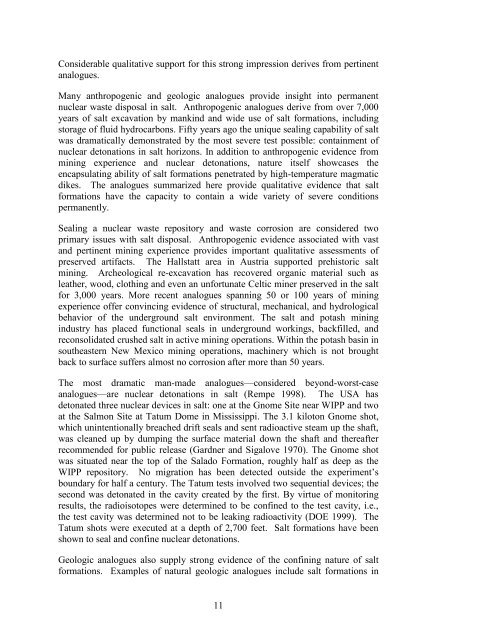Salt Disposal of Heat-Generating Nuclear Waste
Salt Disposal of Heat-Generating Nuclear Waste
Salt Disposal of Heat-Generating Nuclear Waste
Create successful ePaper yourself
Turn your PDF publications into a flip-book with our unique Google optimized e-Paper software.
Considerable qualitative support for this strong impression derives from pertinent<br />
analogues.<br />
Many anthropogenic and geologic analogues provide insight into permanent<br />
nuclear waste disposal in salt. Anthropogenic analogues derive from over 7,000<br />
years <strong>of</strong> salt excavation by mankind and wide use <strong>of</strong> salt formations, including<br />
storage <strong>of</strong> fluid hydrocarbons. Fifty years ago the unique sealing capability <strong>of</strong> salt<br />
was dramatically demonstrated by the most severe test possible: containment <strong>of</strong><br />
nuclear detonations in salt horizons. In addition to anthropogenic evidence from<br />
mining experience and nuclear detonations, nature itself showcases the<br />
encapsulating ability <strong>of</strong> salt formations penetrated by high-temperature magmatic<br />
dikes. The analogues summarized here provide qualitative evidence that salt<br />
formations have the capacity to contain a wide variety <strong>of</strong> severe conditions<br />
permanently.<br />
Sealing a nuclear waste repository and waste corrosion are considered two<br />
primary issues with salt disposal. Anthropogenic evidence associated with vast<br />
and pertinent mining experience provides important qualitative assessments <strong>of</strong><br />
preserved artifacts. The Hallstatt area in Austria supported prehistoric salt<br />
mining. Archeological re-excavation has recovered organic material such as<br />
leather, wood, clothing and even an unfortunate Celtic miner preserved in the salt<br />
for 3,000 years. More recent analogues spanning 50 or 100 years <strong>of</strong> mining<br />
experience <strong>of</strong>fer convincing evidence <strong>of</strong> structural, mechanical, and hydrological<br />
behavior <strong>of</strong> the underground salt environment. The salt and potash mining<br />
industry has placed functional seals in underground workings, backfilled, and<br />
reconsolidated crushed salt in active mining operations. Within the potash basin in<br />
southeastern New Mexico mining operations, machinery which is not brought<br />
back to surface suffers almost no corrosion after more than 50 years.<br />
The most dramatic man-made analogues—considered beyond-worst-case<br />
analogues—are nuclear detonations in salt (Rempe 1998). The USA has<br />
detonated three nuclear devices in salt: one at the Gnome Site near WIPP and two<br />
at the Salmon Site at Tatum Dome in Mississippi. The 3.1 kiloton Gnome shot,<br />
which unintentionally breached drift seals and sent radioactive steam up the shaft,<br />
was cleaned up by dumping the surface material down the shaft and thereafter<br />
recommended for public release (Gardner and Sigalove 1970). The Gnome shot<br />
was situated near the top <strong>of</strong> the Salado Formation, roughly half as deep as the<br />
WIPP repository. No migration has been detected outside the experiment’s<br />
boundary for half a century. The Tatum tests involved two sequential devices; the<br />
second was detonated in the cavity created by the first. By virtue <strong>of</strong> monitoring<br />
results, the radioisotopes were determined to be confined to the test cavity, i.e.,<br />
the test cavity was determined not to be leaking radioactivity (DOE 1999). The<br />
Tatum shots were executed at a depth <strong>of</strong> 2,700 feet. <strong>Salt</strong> formations have been<br />
shown to seal and confine nuclear detonations.<br />
Geologic analogues also supply strong evidence <strong>of</strong> the confining nature <strong>of</strong> salt<br />
formations. Examples <strong>of</strong> natural geologic analogues include salt formations in<br />
11
















